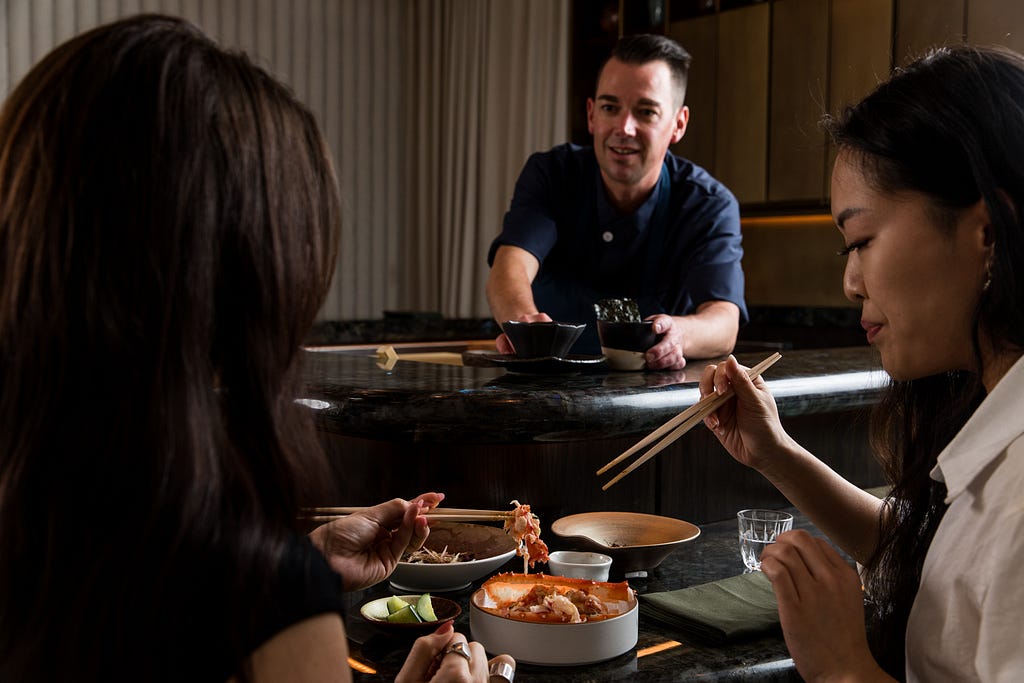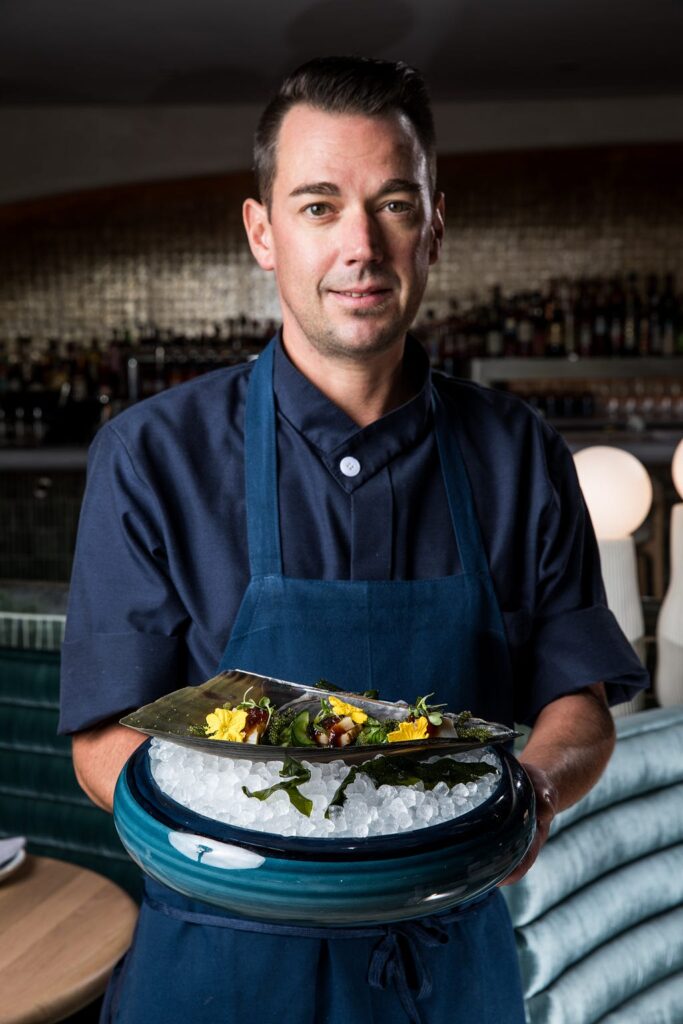Robby Cook Of Coral Omakase / Point Seven On 5 Things You Need To Create a Successful Food or Beverage Brand
An Interview With Martita Mestey
You’re not going to make a lot of money at first. Things will be tight for long hours and not a lot of pay.
As part of our series about the lessons from influential ‘TasteMakers’, I had the distinct pleasure of interviewing Robby Cook.
A graduate of the Institute of Culinary Education in New York City and the California Sushi.
Academy, Robby Cook has worked at some of New York City’s premier Japanese restaurants including Sumile, Ko, Ito Tribeca, and BONDST. It was at BONDST where he connected with Chef Masaharu Morimoto, and went on to work at his flagship restaurant, Morimoto New York, where he worked his way up to Executive Chef after years of extensive training. At Coral, Chef Cook brings a thoughtful approach to the sourcing of ingredients and a respect to the craft of sushi, and also oversees Point Seven’s bento retail concept.
Thank you so much for doing this with us! Our readers would love to ‘get to know’ you a bit. Can you share with our readers a story about what inspired you to become a restauranteur or chef?
I was in college in the early 2000s, and at the time, the original “Iron Chef” series was very popular. I got really into it and began cooking a lot at home. At the same time, I was also working at an organic co-op in Iowa (where I was attending college) handling a lot of produce, often working directly with local farmers. As a result, I became very interested in learning about ingredients that I previously hadn’t had access to, and started working with higher-quality produce.
Do you have a specific type of food that you focus on? What was it that first drew you to cooking that type of food? Can you share a story about that with us?
Japanese food, and more specifically sushi. The original Japanese “Iron Chef” is really what fostered my interest in becoming a chef and learning about Japanese cuisine — it was like nothing I had ever seen before. So it felt incredible and a full circle moment to end up working with Chef Morimoto after watching him on the show!
Can you share the funniest or most interesting story that has happened to you since you became a chef? What was the lesson or take away you took out of that story?
Early on during my time at Morimoto, Ferran Adrià happened to walk into the restaurant for lunch. This was really at the height of his fame, so it was a big deal to the whole staff. I didn’t usually work during lunch, but I got the opportunity to step in and prepare some sushi for him. He wanted something simple and straightforward, and when preparing food for a chef at that level, it’s really just about doing your best and serving the best quality ingredients. He came back three times after that, which was pretty cool.
Can you tell us a story about the hard times that you faced when you first started your journey? How did you overcome this obstacle?
When I first started as a sushi chef around 2003, it was pretty hard to get a job. I was a white chef working in the world of Japanese cuisine, so it took a lot of persistence. After graduating from the California Sushi Academy, I finally met a great Japanese chef who took me under his wing and showed me the ropes so that I could build a really solid foundation of skills.
In your experience, what is the key to creating a dish that customers are crazy about?
Using super high-quality ingredients and adding an element of surprise to create something they’ve never had before. That can be in the form of a side component or a new type of fish, for example. Recently I’ve been trying to do this by adding bold citrus flavors and unique varieties of fruit. There’s a farmer in New Jersey called Flavors by Bhumi who is producing amazing yuzu and other citrus that I’ve been including as part of my offerings.
Personally, what is the ‘perfect meal for you?
Pasta. Simple, fresh pasta. Or a traditional Japanese meal — clean flavors, balanced, healthy.
Where does your inspiration for creating come from? Is there something that you turn to for a daily creativity boost?
The ocean. There’s so much sea life, and so much high-quality seafood coming from the ocean. The high quality of ingredients also inspires me to make sure I’m doing my best to make sure customers can appreciate the quality of simple ingredients, too. I’m also pretty inspired by music. I have had the opportunity to meet some pretty interesting people in the music industry from this job, many of whom I look up to, which is pretty inspiring too.
Are you working on any new or exciting projects now? What impact do you think this will have?
We recently opened Coral omakase,a 10-seat sushi counter located in the back of Point Seven. We’ll also soon be launching a more casual take-out sushi counter in the same building in 2024.
What advice would you give to other chefs or restaurateurs to thrive and avoid burnout?
Try your best, have good equipment, and keep your knives sharp — it will make your life easier. Stay focused, but take breaks throughout the day and don’t forget to eat something good. Don’t work a 12 hour shift straight. And stay off your phone.

Thank you for all that. Now we are ready for the main question of the interview. What are your “5 Things I Wish Someone Told Me When I First Started as a Chef” and why?
- The hours will be long. There will be very long days, and very late nights.
- The kitchen can be an intense place at times, so be ready. Especially in bigger kitchens, where there are a lot of personalities.
- It’s more physically dangerous than you would think. The amount of times I have been cut or had major injuries is… a lot.
- You’re not going to make a lot of money at first. Things will be tight for long hours and not a lot of pay.
- It’s less glamorous than it may appear from the outside. There’s a lot of hard work that goes into this.
What’s the one dish people have to try if they visit your establishment?
Right now, Buri — a wild king yellowtail that’s in season during the winter that I’ve been serving with a charred scallion ponzu and myoga. It comes with crispy nori and some white truffle on top since it’s in season. The fish is a little fatty, the charred scallion ponzu adds some smokiness, and the truffles add some earthiness. It’s great.
You are a person of enormous influence. If you could inspire a movement that would bring the most amount of good to the most amount of people, what would that be? You never know what your idea can trigger.
Giving back to younger people, and passing down generational knowledge about how to do things properly, take care of their equipment, and generally share information.
Thank you for these fantastic insights. We greatly appreciate the time you spent on this.
Robby Cook Of Coral Omakase / Point Seven On 5 Things You Need To Create a Successful Food or… was originally published in Authority Magazine on Medium, where people are continuing the conversation by highlighting and responding to this story.
